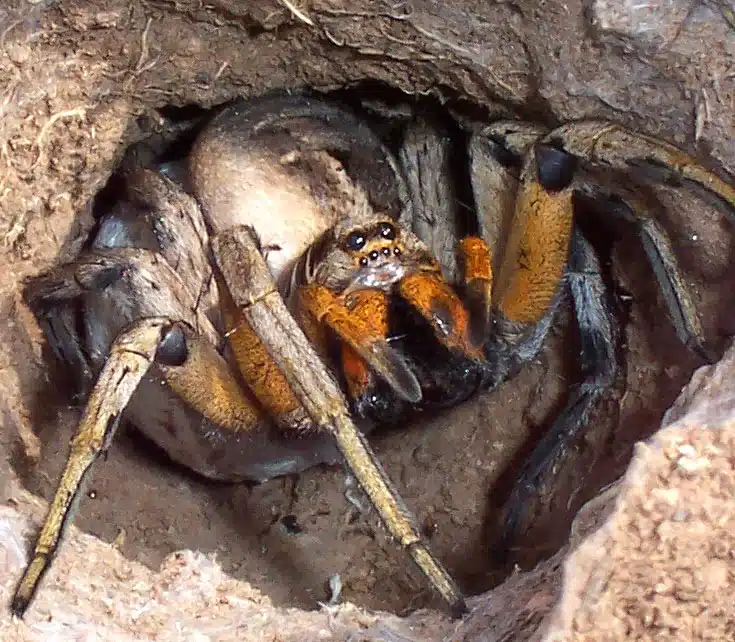When you spot a brown spider in your home, fear often kicks in immediately. Is it dangerous? Will it bite? Should you call someone right away? These concerns are completely understandable, especially when trying to identify whether you’re dealing with a wolf spider vs brown recluse.
In my years working with pest control throughout the Mid-Atlantic region, spiders consistently rank among the top concerns homeowners contact us about. This is particularly true in wooded areas like Mt. Vernon, where abundant trees and moisture create ideal conditions for spider populations to thrive rapidly around homes. I’ve seen these creatures establish themselves quickly in eaves, under porches, and sometimes even inside homes.
Proper identification is crucial because the urgency and treatment approach can vary significantly between species. While both spiders can cause alarm when discovered indoors, understanding the key differences between wolf spider vs brown recluse will help you respond appropriately and avoid unnecessary panic.
Basic Description: Brown Recluse vs Wolf Spider Identification
The fundamental difference between wolf spider vs brown recluse begins with their scientific classification and hunting behavior. Wolf spiders belong to the family Lycosidae, which includes over 2,000 species worldwide. These are ground hunters that don’t spin capture webs but instead actively chase down their prey.
Brown recluse spiders, scientifically known as Loxosceles reclusa, belong to the family Sicariidae. They’re considered medically important because of their cytotoxic venom containing sphingomyelinase-D. Additionally, brown recluse spiders are secretive creatures that prefer undisturbed indoor spaces.
Both species play different roles in our local ecosystem. Wolf spiders help control pest populations by hunting mosquitoes, flies, and other nuisance insects. Brown recluse spiders, while less beneficial due to their reclusive nature, still consume various small insects in their hidden habitats.
Physical Identification: Is it a Brown Recluse or a Wolf Spider?
The most reliable way to distinguish between wolf spider vs brown recluse is through careful examination of specific physical characteristics. These differences are consistent across individuals and can help you make an accurate identification even under stressful circumstances.
Eye Patterns: The Most Reliable Identifier
Wolf spiders have 8 eyes arranged in three distinct rows: four small eyes at the bottom, two large eyes in the middle, and two medium-sized eyes on top. The two large median eyes contain a reflective layer called a tapetum, which creates an distinctive “eyeshine” when you shine a flashlight on them at night.
Brown recluse spiders have only 6 eyes arranged in three pairs or dyads. This 6-eye configuration is rare among spiders and serves as a key diagnostic feature. Because most people don’t expect spiders to have anything other than 8 eyes, this difference often surprises homeowners.
Body Size and Overall Build
When examining body length (excluding legs), wolf spiders typically measure 10-35 mm, with larger species like Tigrosa reaching the upper end of this range. Brown recluse spiders are generally smaller, measuring 6-20 mm in body length. However, leg span can make size comparison tricky, so focus on the actual body dimensions.
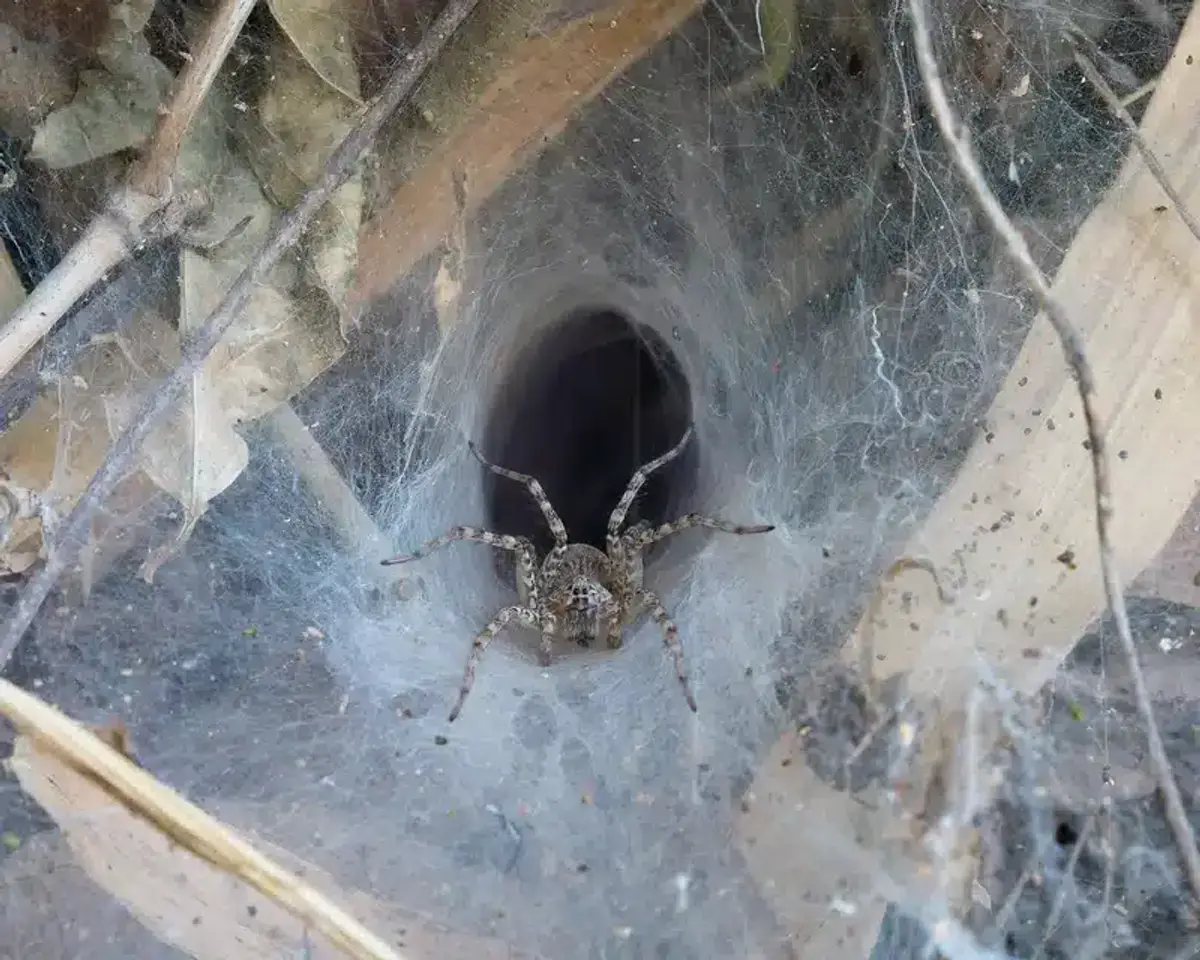
Wolf spiders have robust, sturdy builds with thick legs designed for running and jumping. Their bodies appear more muscular and substantial. Brown recluse spiders have more delicate builds with longer, thinner legs relative to their body size.
Coloration and Markings
The marking patterns create another clear distinction in wolf spider vs brown recluse identification. Brown recluse spiders display the famous violin or fiddle-shaped mark on their cephalothorax (the front body section). This mark typically appears darker than the surrounding body color. Importantly, their legs remain uniformly light colored without any banding or patterns.
Wolf spiders never display violin markings. Instead, they show mottled, striped, or banded patterns across their bodies and legs. Their coloration tends to be more varied, often incorporating browns, grays, and sometimes lighter accent colors in complex patterns.
Hair and Texture Differences
The presence or absence of hair provides another distinguishing factor between wolf spider vs brown recluse. Wolf spiders are notably hairy, with visible setae (bristles) covering their legs and body. This hair gives them a somewhat fuzzy appearance and helps with sensory perception.
Brown recluse spiders have smooth legs and bodies with minimal visible hair. Their appearance is much more streamlined and sleek compared to the fuzzy wolf spider.
Web Building and Nesting: Wolf Spider vs Brown Recluse Harborage
Understanding nesting and web-building behavior helps explain where you’re likely to encounter each species and how to approach treatment. The differences in wolf spider vs brown recluse harborage preferences directly impact control strategies.
Wolf spiders don’t build capture webs at all. Instead, females carry their round silk egg-sacs attached to their spinnerets until the eggs hatch. After hatching, spiderlings climb onto their mother’s abdomen and ride there until they’re ready to disperse. Some wolf spider species line underground burrows with silk, but they don’t create the typical webs most people associate with spiders.
Brown recluse spiders create small, irregular webs in secluded areas, but these aren’t used for prey capture. They hide their papery white egg-sacs, which measure approximately 8 mm in diameter, in dark crevices. Common hiding spots include behind storage boxes, under loose bark, in attic joists, and within wall voids.
From my experience treating homes in this region, both species commonly establish themselves in eaves, under porches, and in similar protected areas around home exteriors. Because they prefer different microenvironments, we’ve developed our two-pronged approach using a webster tool for web removal followed by non-repellent perimeter treatments along the foundation to address both species effectively.
Behavior and Activity Patterns
The behavioral differences between wolf spider vs brown recluse affect when and where homeowners encounter them. These patterns also influence treatment timing and methods.
Wolf spiders are nocturnal cursorial hunters, meaning they actively roam at night searching for prey. They often enter houses during fall months while seeking warmth or chasing prey insects. Because they’re mobile hunters, you might spot them moving across floors or walls, especially in evening hours.
Brown recluse spiders live up to their name through secretive, reclusive behavior. They move slowly and deliberately, preferring undisturbed indoor clutter where they can remain hidden. Brown recluse spiders forage at night following specific patterns, but they’re rarely seen because they quickly retreat when disturbed.
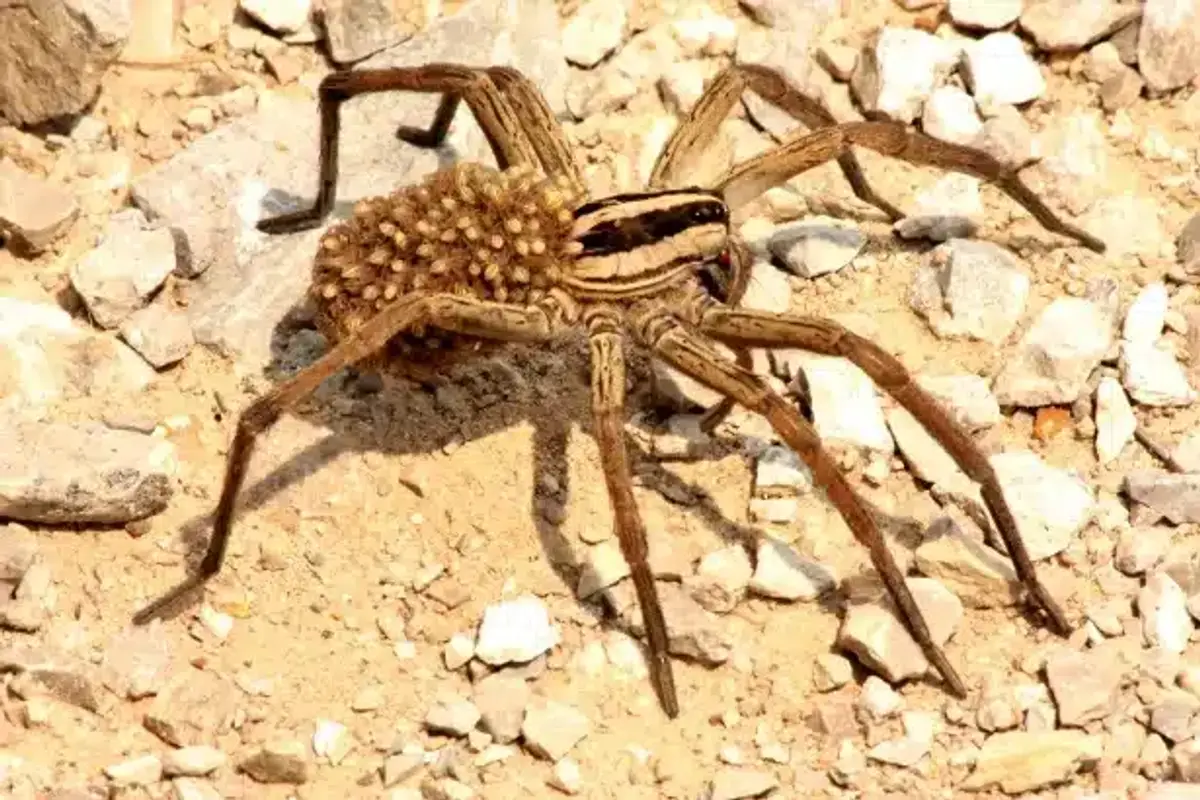
The parental care behaviors also differ significantly. Wolf spider mothers provide extended care, carrying babies on their backs for protection. Brown recluse spiderlings receive no parental care and must fend for themselves immediately after hatching.
Geographic Distribution in Our Region
Understanding the geographic distribution of wolf spider vs brown recluse is critical for accurate identification and appropriate response. This information often surprises homeowners who assume brown recluse spiders are common throughout our region.
Wolf spiders occur naturally throughout Virginia, Maryland, and Washington DC. You’ll find them in lawns, gardens, basements, and garages across our entire service area. They thrive in the diverse habitats our region provides, from urban environments to heavily wooded areas.
Critical Geographic Information
Established brown recluse populations exist only in extreme southwestern Virginia. Maryland and Washington DC have no native brown recluse populations whatsoever. Any brown recluse found in these areas represents hitchhikers that arrived in shipments or moving boxes and cannot survive winters outside heated structures.
This geographic reality means that statistically, any brown spider you encounter in Maryland or DC is almost certainly not a brown recluse. However, I always advise customers to remain cautious and call for professional identification when they’re uncertain about spider species found indoors.
Climate modeling suggests possible northeastern range expansion for brown recluse spiders under high-emission scenarios, but these models indicate coastal Maryland colonization remains unlikely within the next several decades.
Seasonal Activity and Indoor Encounters
The timing of wolf spider vs brown recluse indoor sightings follows predictable seasonal patterns that can aid in identification and treatment planning.
Wolf spider activity peaks during late summer and fall months, particularly during their mating migration period. This seasonal surge explains why homeowners often report sudden increases in wolf spider sightings during September and October. Additionally, cooling temperatures drive them to seek shelter indoors.
Brown recluse activity remains relatively stable year-round in indoor environments because they live within heated structures. However, human encounters increase during July through September when rising attic temperatures drive them downward into living spaces seeking cooler areas.
Understanding these patterns helps both with identification and treatment timing. For instance, increased spider activity during fall months more likely indicates wolf spiders rather than brown recluse in our region.
Medical Significance: Wolf Spider vs Brown Recluse Bites
The medical implications represent perhaps the most important distinction between wolf spider vs brown recluse encounters. While both can bite when threatened, the severity and treatment requirements differ dramatically.
Wolf spider bites typically cause only localized pain and mild swelling. Systemic reactions are rare, and most cases respond well to basic first aid including wound cleaning and cold compress application. These bites generally heal without complications or medical intervention.
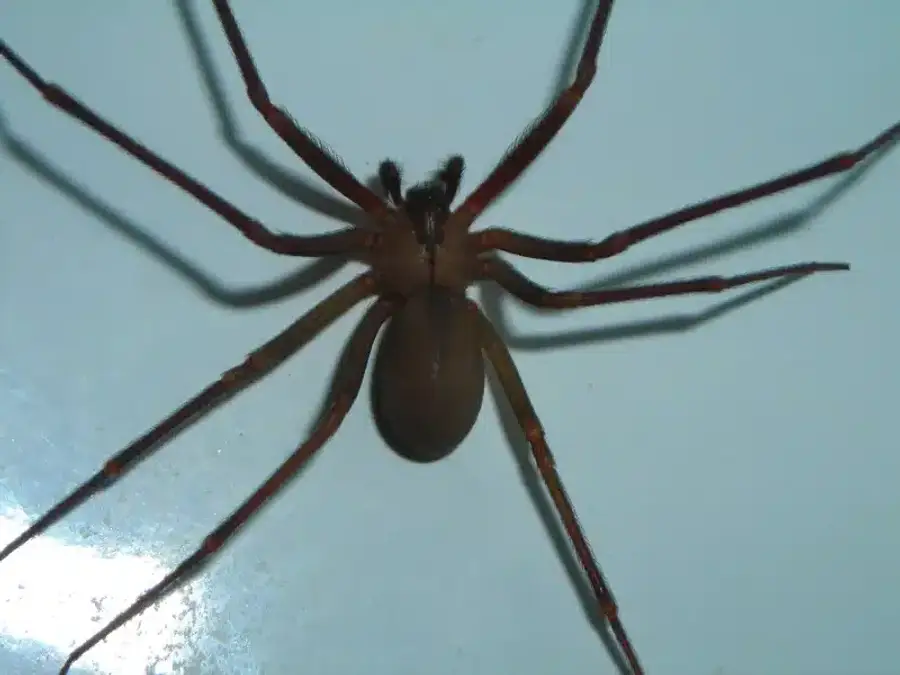
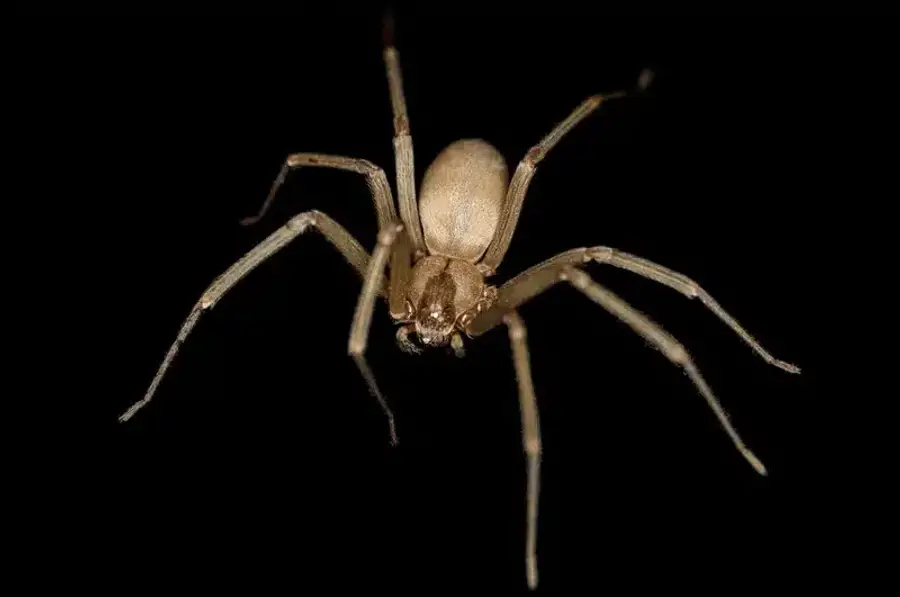
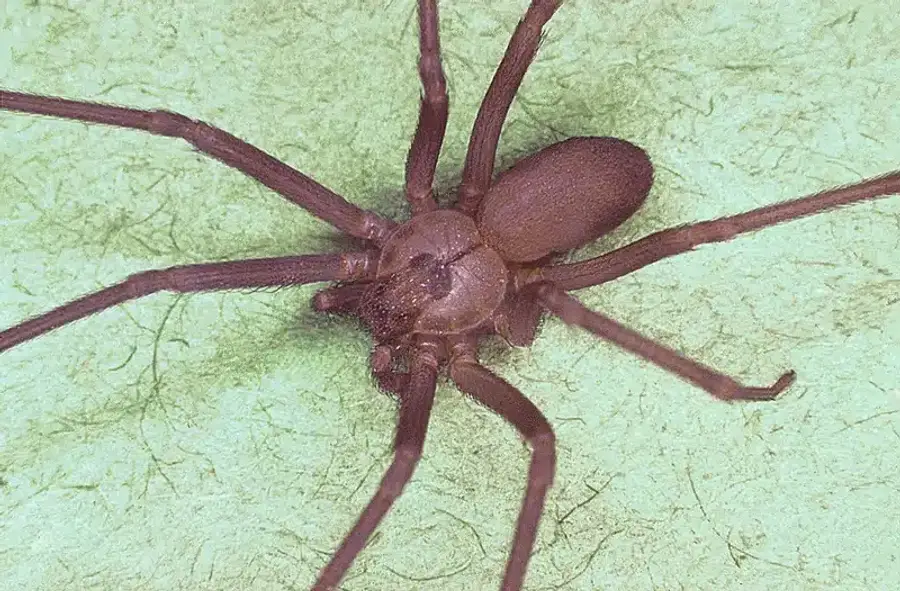
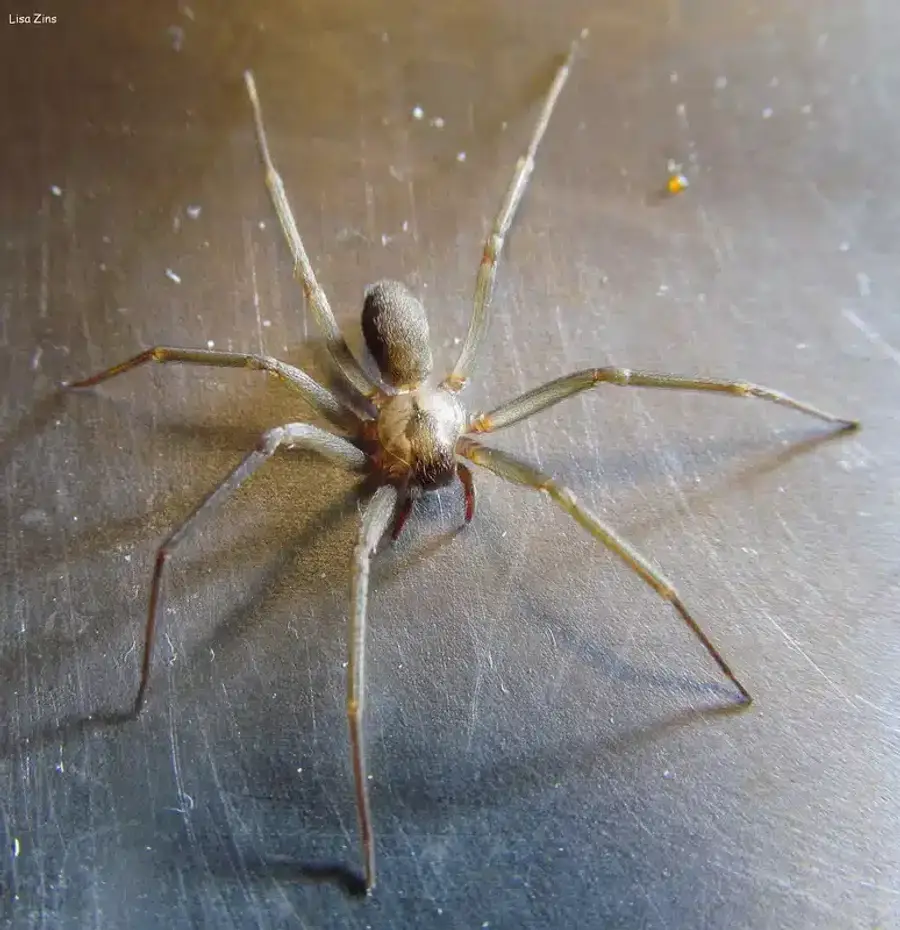
Brown recluse bites present more serious concerns. The venom contains cytotoxic compounds that can cause tissue death (dermonecrosis) in approximately 10% of cases. Systemic effects including hemolysis can occur, particularly in children and elderly individuals. No antivenom exists in the United States, so treatment focuses on wound care, tetanus prevention, and possible surgical intervention for severe tissue damage.
Medical Alert
Seek medical evaluation for any suspected brown recluse bite, especially if you develop expanding redness, tissue breakdown, or systemic symptoms. However, remember that confirmed brown recluse bites remain extremely rare in Maryland and DC given the absence of established populations.
The Misdiagnosis Problem
One significant issue complicating wolf spider vs brown recluse identification involves frequent misdiagnosis of skin conditions as brown recluse bites. MRSA infections, vasculitis, and other dermatoses are often incorrectly labeled as recluse bites, particularly outside the spider’s endemic range.
This misdiagnosis problem creates unnecessary fear and can delay appropriate medical treatment for the actual condition. Healthcare providers and patients should consider brown recluse bites extremely unlikely in areas without established populations.
Education about proper identification and geographic distribution helps reduce these false alarms. When skin lesions develop without confirmed spider encounters, other causes should be investigated first in our region.
Ecological Benefits of Both Species
Before discussing control methods, it’s important to understand why both wolf spiders and brown recluse serve beneficial ecological functions. This perspective influences whether removal or elimination makes the most sense for your situation.
Wolf spiders are particularly valuable predators that consume significant numbers of pest insects including mosquitoes, flies, crickets, and other nuisance species. A single wolf spider can remove dozens of pest insects per week from your property. Learn more about spider identification to better appreciate the diversity of beneficial species around your home.
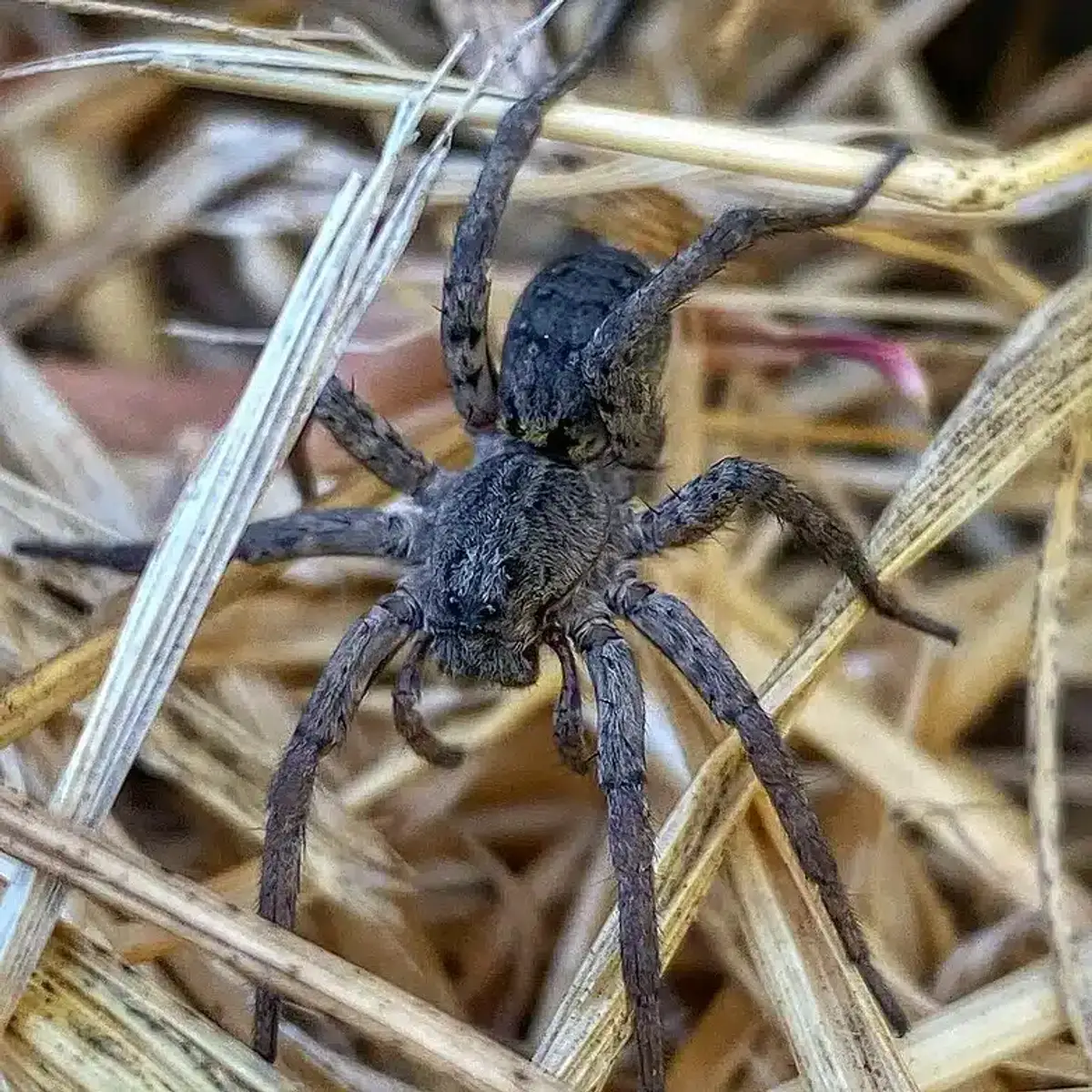
Even brown recluse spiders, despite their medical significance, consume various small insects in their hidden habitats. Additionally, because they stay hidden and avoid human contact, they rarely create ongoing problems in homes.
This ecological value means that complete elimination isn’t always necessary or advisable. Often, targeted removal from indoor areas while maintaining outdoor populations provides the best balance between pest control and ecosystem health.
Professional Control Approach
Throughout my experience treating spider issues in wooded areas and urban environments, we’ve refined our approach to address both wolf spider vs brown recluse effectively. Our method addresses the rapid establishment patterns I’ve observed, particularly in areas with abundant trees and moisture.
The first component involves physical removal using a webster tool to eliminate existing webs from accessible areas including eaves, porches, and entry points. This immediate reduction tackles current populations while preventing further establishment in these preferred locations.
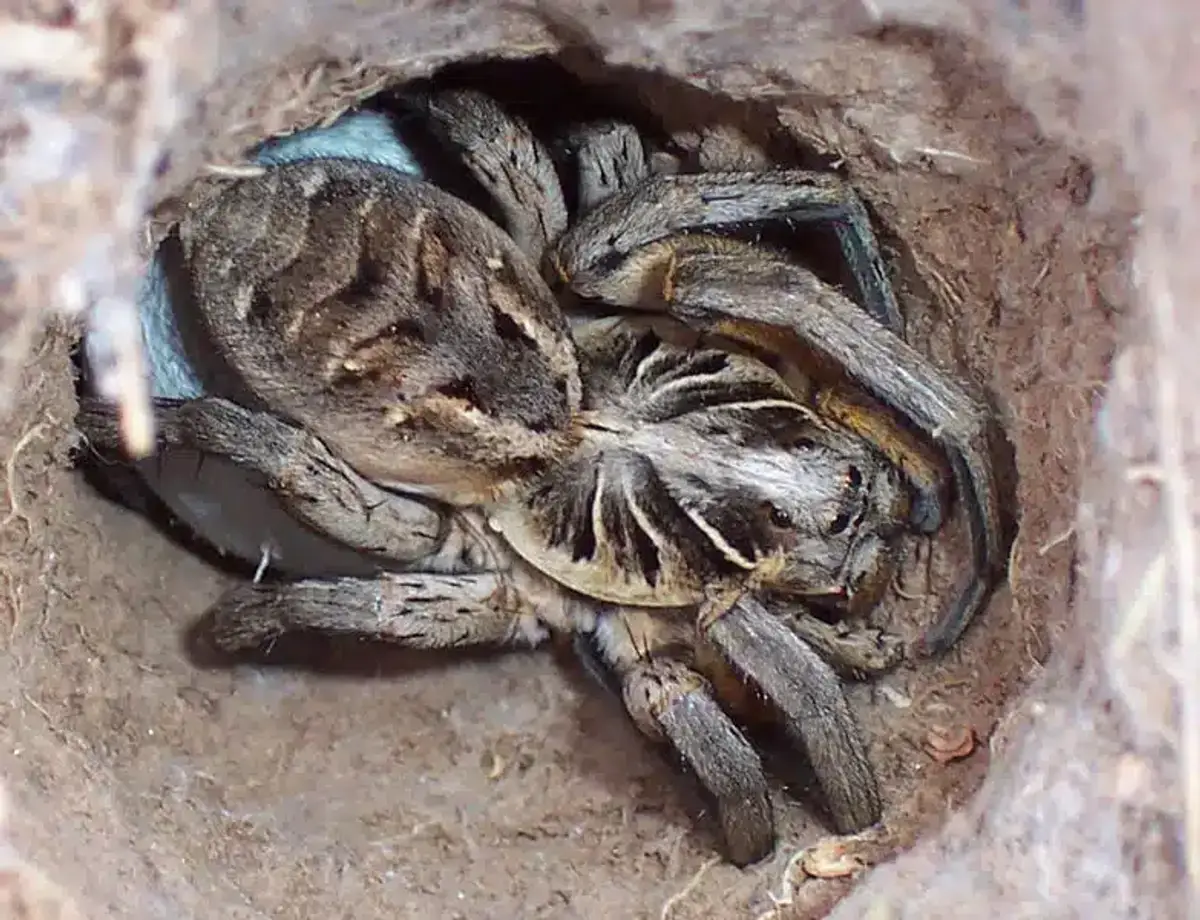
Following web removal, we apply non-repellent perimeter treatments along the foundation and other key areas. This creates a protective barrier that intercepts spiders attempting to enter structures while allowing the products time to work effectively.
This two-pronged approach works particularly well in our region because it addresses both the immediate problem and provides ongoing protection. However, because spiders don’t always access homes through the same entry points as crawling insects, some species require specialized treatment strategies.
Inspection and Monitoring Methods
Effective wolf spider vs brown recluse management starts with thorough inspection and ongoing monitoring. Different techniques work better for each species based on their distinct behaviors and preferences.
For wolf spider detection, nighttime surveys using flashlights can reveal the characteristic eyeshine from their reflective median eyes. This technique works particularly well around outdoor areas where wolf spiders hunt actively.
Both species can be monitored using glue boards or sticky traps placed along baseboards and behind appliances. These traps not only capture hunting spiders but also provide population indices that help gauge treatment effectiveness over time.
Brown recluse monitoring requires targeted crack-and-crevice searches in likely harborage areas. Focus on closets, storage areas, and undisturbed spaces where egg-sacs might be hidden. Understanding whether spiders are actually insects helps homeowners know what to look for during inspections.
Regular monitoring allows for early detection of problems and helps determine when professional intervention might be needed.
Non-Chemical Prevention Strategies
The most effective long-term approach to wolf spider vs brown recluse management emphasizes prevention through environmental modification and exclusion techniques. These methods reduce spider populations without relying solely on chemical treatments.
These prevention strategies work for both wolf spider vs brown recluse while reducing many other pest issues simultaneously. Check out our comprehensive spider removal guide for additional detailed prevention methods.
Chemical Treatment Options
When prevention measures alone aren’t sufficient, targeted chemical treatments can provide effective wolf spider vs brown recluse control. Product selection and application methods vary based on the target species and location requirements.
Residual micro-encapsulated pyrethroids such as bifenthrin and lambda-cyhalothrin work well for perimeter treatments around foundations, in voids, and along baseboards. These formulations provide extended residual activity that can persist for 30+ days when properly applied.
For brown recluse control specifically, dust formulations including silica aerogel and deltamethrin dust prove particularly effective in wall voids and other hidden harborage areas. These products maintain effectiveness longer in protected areas and reach spaces where liquid sprays can’t penetrate.
Pyrethrin-based aerosols provide immediate knockdown for flushing spiders from hiding places, though they offer no residual protection. These work well in combination with vacuum removal for immediate population reduction.
Chemical Treatment Safety
All chemical treatments must list “spiders” on the product label and should be applied according to manufacturer specifications. In our Chesapeake Bay watershed region, special care must be taken to prevent runoff that could affect aquatic environments.
Removing Egg-Sacs and Harborage Areas
Professional Resources and Guidelines
Several authoritative sources provide detailed guidance for wolf spider vs brown recluse identification, distribution, and management. These resources can help homeowners make informed decisions and provide healthcare providers with accurate information.
Virginia Tech Cooperative Extension publishes comprehensive fact sheets covering identification, biology, and control recommendations specific to our region. Their materials include high-resolution photographs that aid in accurate species identification.
The CDC and NIOSH provide occupational guidance on venomous spider encounters, including medical signs and symptoms of envenomation. This information proves valuable for both professionals and homeowners concerned about bite treatment.
National Pesticide Information Center (NPIC) offers detailed IPM guidance covering non-chemical management strategies, pesticide selection, and environmental considerations for spider control.
These resources provide science-based information that homeowners can trust when making decisions about spider management in their homes.
Regional Insights and Treatment Experience
My experience working in wooded areas throughout our region has revealed consistent patterns in spider establishment and management. Trees and moisture create ideal conditions where spider populations can build up rapidly, particularly around home exteriors.
In areas like Mt. Vernon, we frequently encounter situations where spiders establish themselves in eaves and under porches within days of previous treatments. This rapid re-establishment explains why ongoing maintenance proves so important for effective control.
Our tri-annual approach (three times per year) maintains the protective barrier while addressing seasonal population fluctuations. Each visit includes dewebbing accessible areas and reapplication of perimeter treatments as needed. This consistent maintenance approach, backed by our family’s 57 years in the pest control business and over 300 years of combined team experience, provides homeowners with reliable ongoing protection.
Key Insight from Professional Experience
Consistent prevention works better than reactive treatment. Homeowners who maintain regular service schedules experience fewer spider problems and require less intensive interventions over time.
Key Takeaways for Local Homeowners
Essential Points for Spider Management
When dealing with wolf spider vs brown recluse identification and management in the Virginia, Maryland, and DC region, several key points can guide your decisions and actions:
Brown recluse spiders are extremely unlikely in Maryland and DC. Use the eye count (6 vs 8) and violin marking to confirm identification, but remember that geographic probability strongly favors other species in our region.
Wolf spiders provide beneficial pest control despite their intimidating size. Consider removal rather than elimination when possible, focusing efforts on keeping them out of living spaces while tolerating outdoor populations.
Consistent prevention through sanitation and exclusion eliminates the need for broad-spectrum chemical treatments in most situations. Professional perimeter treatments combined with good housekeeping practices provide effective long-term control.
If you’re unsure about spider identification or dealing with persistent problems, don’t hesitate to contact our registered technicians for professional assessment. Understanding the differences between arachnids and insects can help you communicate more effectively about the specific issues you’re experiencing.
For homeowners throughout Arlington, Alexandria, Bethesda, and Reston, our team provides expert identification and targeted treatment plans designed specifically for Mid-Atlantic spider species. Visit our comprehensive spider resource page for additional information about the species common to our region.
Frequently Asked Questions
How can I quickly tell the difference between a wolf spider vs brown recluse?
+
Count the eyes (wolf spiders have 8, brown recluse have 6) and look for the violin-shaped marking on the brown recluse's front body section. Wolf spiders are hairy with banded legs, while brown recluse spiders are smooth with uniform light-colored legs.
Are brown recluse spiders common in Maryland and Virginia?
+
Brown recluse spiders are not established in Maryland or DC and exist only in extreme southwestern Virginia. Any brown spider found in the greater DC metro area is almost certainly not a brown recluse.
What should I do if I find spider egg-sacs in my home?
+
Vacuum wolf spider egg-sacs along with the carrying female, then discard the bag outdoors. For suspected brown recluse egg-sacs, use long-handled tools to place them in soapy water or freeze for 48+ hours. Never crush egg-sacs as this can scatter spiderlings.
When do wolf spiders vs brown recluse typically enter homes?
+
Wolf spiders peak indoors during late summer and fall seeking warmth or chasing prey. Brown recluse activity remains steady year-round in heated structures, but encounters increase July through September when attic heat drives them to cooler areas.
How dangerous are wolf spider bites compared to brown recluse bites?
+
Wolf spider bites cause only mild local pain and swelling that responds to basic first aid. Brown recluse bites can cause tissue death in 10% of cases and may require medical treatment, though confirmed bites are extremely rare in our region.
What attracts spiders to my house and how can I prevent them?
+
Spiders follow prey insects attracted by exterior lighting, moisture problems, and food sources. Prevention includes using less attractive lighting, controlling moisture, sealing entry points, and maintaining clean, clutter-free environments.
Should I use pesticides for wolf spider vs brown recluse control?
+
Start with non-chemical methods like sanitation, exclusion, and habitat modification. Professional perimeter treatments work well when needed, but avoid broad-spectrum spraying. Target treatments to specific harborage areas for best results.
How can I tell if I have brown recluse spiders or just similar-looking species?
+
Focus on the 6-eye arrangement, violin marking, and geographic likelihood. In Maryland and DC, brown-colored spiders are typically wolf spiders, house spiders, or other common species rather than brown recluse. If you're dealing with spider concerns or need professional identification of wolf spider vs brown recluse in your home, our licensed technicians can provide expert assessment and targeted treatment solutions. Call us at 703-683-2000 or email info@bettertermite.com for a consultation with one of our registered pest control professionals.
With five years of hands-on experience in the pest control industry, George Schulz is a registered technician with the Virginia Pest Management Association and a proud third-generation professional in a family business that's been protecting homes for over 57 years. He manages and trains a team of service pros while also leading internal research efforts—recently spearheading a deep-dive review of thousands of documents on pest control materials to hand-pick the most kid and pet friendly, most effective solutions tailored specifically for homes in the DC metro area.
